December Data - February Reporting
MICHIGAN'S UNEMPLOYMENT RATE REMAINED STABLE IN DECEMBER

Michigan’s seasonally adjusted unemployment rate was unchanged between November and December at 4.3 percent.
The national unemployment rate remained constant at 3.7 percent over the month. At the statewide level, the jobless rate was six-tenths of a percentage point above the U.S. rate. Over the year, the U.S. unemployment rate increased by 0.2 percentage points, while the statewide unemployment rate remained unchanged since December 2022. Michigan’s jobless rate of 4.3 percent tied with Arizona, Kentucky, and West Virginia as the seventh highest rate in the nation.
Michigan’s workforce rose by 0.2 percent during December, while the U.S. workforce receded by 0.4 percent. Over the month, statewide employment levels edged up by 0.2 percent, while national employment fell by 0.4 percent. Statewide unemployment levels remained unchanged over the same period, while unemployment levels rose 0.1 percent nationally.
Over the year, Michigan’s labor force advanced by 4.4 percent, 2.9 percentage points above the workforce increase seen nationally. Statewide employment totals rose by 4.4 percent, while national employment increased by 1.2 percent. Since December 2022, total unemployment in Michigan rose by 3.3 percent, while total unemployment in the U.S. jumped by 10.0 percent.
Statewide annual average data revealed that the unemployment rate in 2023 was 4.0 percent, 0.2 percentage points below the 2022 annual average rate. This marked the third consecutive year of declining annual average unemployment rates in Michigan. Over the year, all 17 Michigan labor market areas observed annual average unemployment rate declines, with a median reduction of 0.2 percentage points. In 2023, 13 of the 17 major areas recorded annual average unemployment rates greater than or equal to the statewide rate (4.0 percent).

Source: Local Area Unemployment Statistics, Michigan Center for Data and Analytics, Michigan Department of Technology, Management & Budget
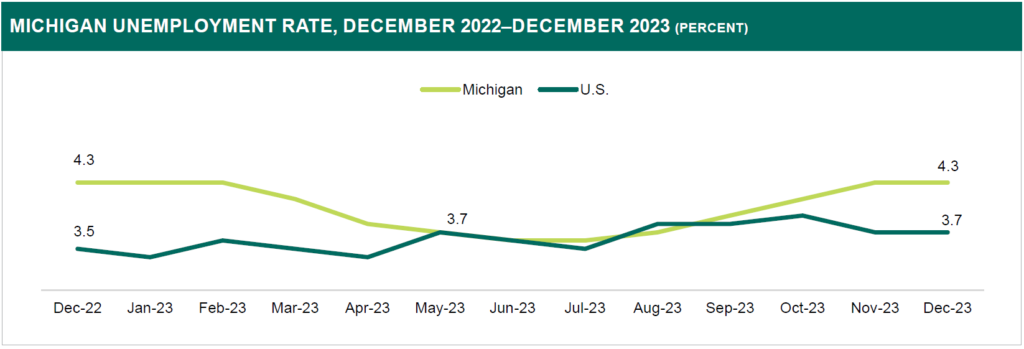
Source: Local Area Unemployment Statistics, Michigan Center for Data and Analytics, Michigan Department of Technology, Management & Budget
Michigan’s annual average unemployment rate of 4.0 percent tied with Washington as the 10th highest rate nationwide. Between 2022 and 2023, Michigan’s annual rate decline of 0.2 percentage points tied with seven states as the 16th largest drop in the U.S.
For more information on state and regional unemployment rates for Michigan, view full press releases at Michigan.gov/LMI.
REIMA NASSER
Economic Analyst
MICHIGAN NONFARM PAYROLL JOBS INCREASE IN DECEMBER
Total nonfarm payroll jobs in Michigan rose in December, increasing by 8,900 or 0.2 percent over the month, to 4,435,500. Payroll jobs have advanced in nine months in the last year. As of December 2023, statewide employment has remained 14,000 or 0.3 percent below its February 2020 pre-pandemic level. Michigan was ranked sixth highest among all U.S. states for largest payroll job level change in December.
On the national level, total nonfarm payroll jobs rose 0.2 percent in December, similar to the statewide change. Nationally, this marked the 36th consecutive month of recorded job gains on a seasonally adjusted basis.
Seven of Michigan’s 11 statewide supersectors recorded seasonally adjusted job gains during December. On a numeric basis, notable job gains were recorded in multiple major industry sectors, including Leisure and hospitality (+3,700), Construction (+3,300), and Manufacturing (+2,000). The large increase in payroll jobs in the Leisure and hospitality sector was partially due to the end of the casino workers strike in early December. The Professional and business services sector experienced the largest jobs decline in December, decreasing by 1,500 or 0.2 percent, over the month.
Nationally, seasonally adjusted jobs gains were recorded in every major industry sector excluding Other services, which declined by 1,000 over the month.
Most Major Industries Have Added Jobs Since Last Year
Since December 2022, eight of Michigan’s 11 super sectors recorded seasonally adjusted job growth. Over the year, total payroll jobs increased by 45,700 or 1.0 percent. Compared to all U.S. states, Michigan’s rate increase ranked 38th lowest, matching that of Oklahoma, Oregon, and Nebraska. The largest major industry additions occurred in the Government (+19,200); Private education and health services (+14,800); and Trade, transportation, and utilities (+10,500) sectors.
Nationally, payroll jobs increased by 2.0 percent over the year. Every major industry sector except for Information (-2.5 percent) recorded job gains over the year. The Private education and health services (+4.3 percent), Leisure and hospitality (+3.4 percent), Construction (+3.1 percent), and Government (+3.1 percent) sectors recorded the largest yearly job gains.
December Job Rates Decrease in Most Metro Areas
On a not seasonally adjusted basis, 10 of Michigan’s 14 Metropolitan Statistical Areas (MSAs) lost jobs in December. Three regions, Midland (+0.3 percent), Muskegon (+0.2 percent), and Flint (+0.1 percent) observed job additions, while Grand Rapids was unchanged. Seven MSAs experienced job declines greater than the statewide average (-0.3 percent), with Saginaw (-1.2 percent) having recorded the greatest percent decline.
Over the month, total employment within the Manufacturing and Trade, transportation, and utilities industry sectors remained either unchanged or increased in most Michigan metro areas.
Since December 2022, total nonfarm employment in 12 of Michigan’s 14 metro areas experienced job growth. The Detroit MSA (-0.2 percent) was the only area to note a job decline over the year, while Battle Creek was unchanged. Ann Arbor (+3.8 percent), Midland (+3.4 percent), and Bay City (+1.7 percent) recorded the three largest percent increases changes over the year.
DYLAN SCHAFER
Federal/State Program Manager
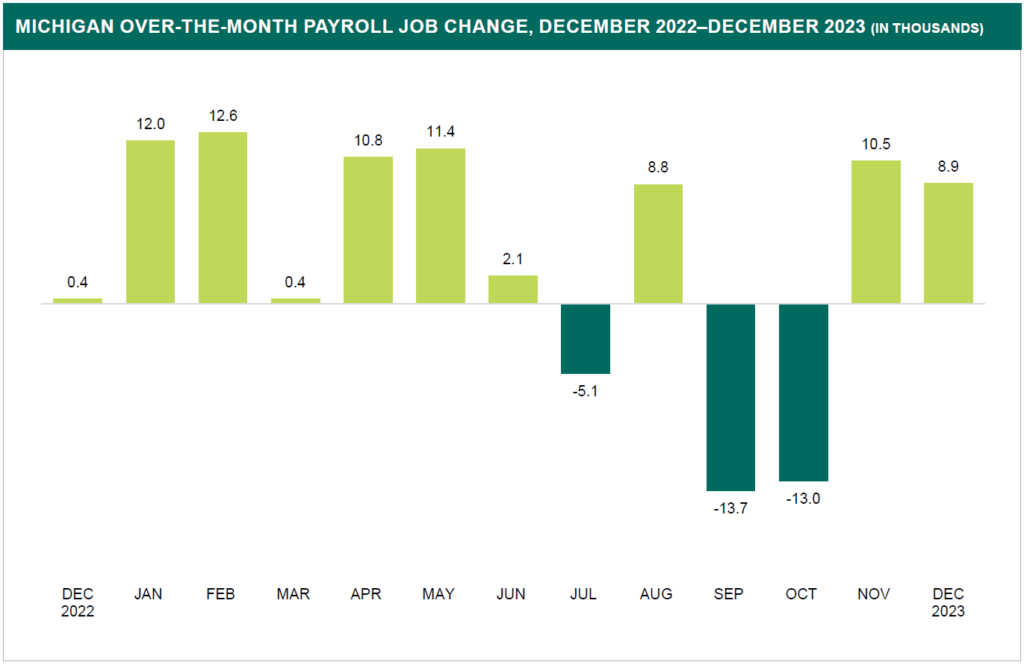
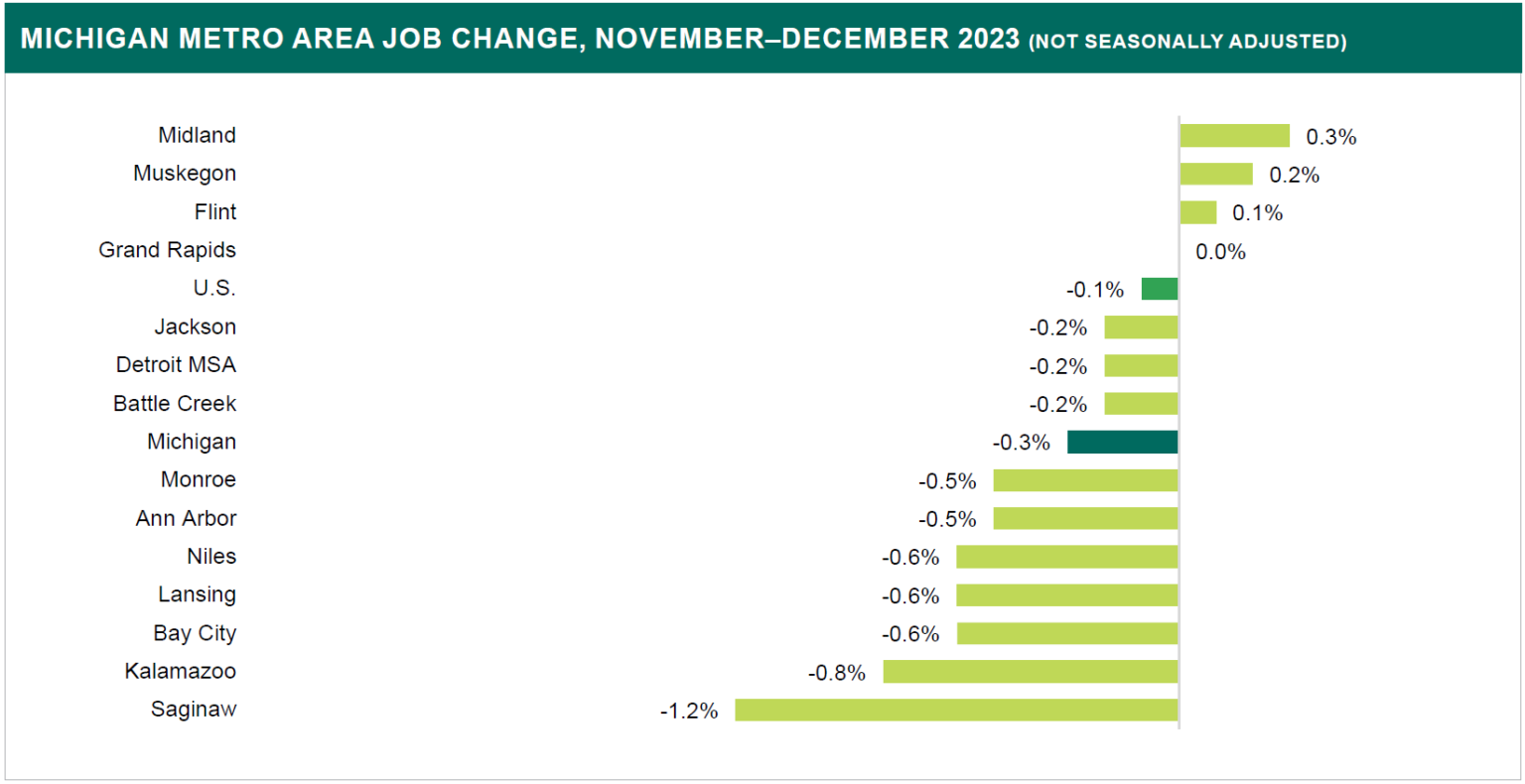
Source: Current Employment Statistics, Michigan Center for Data and Analytics, Michigan Department of Technology, Management & Budget
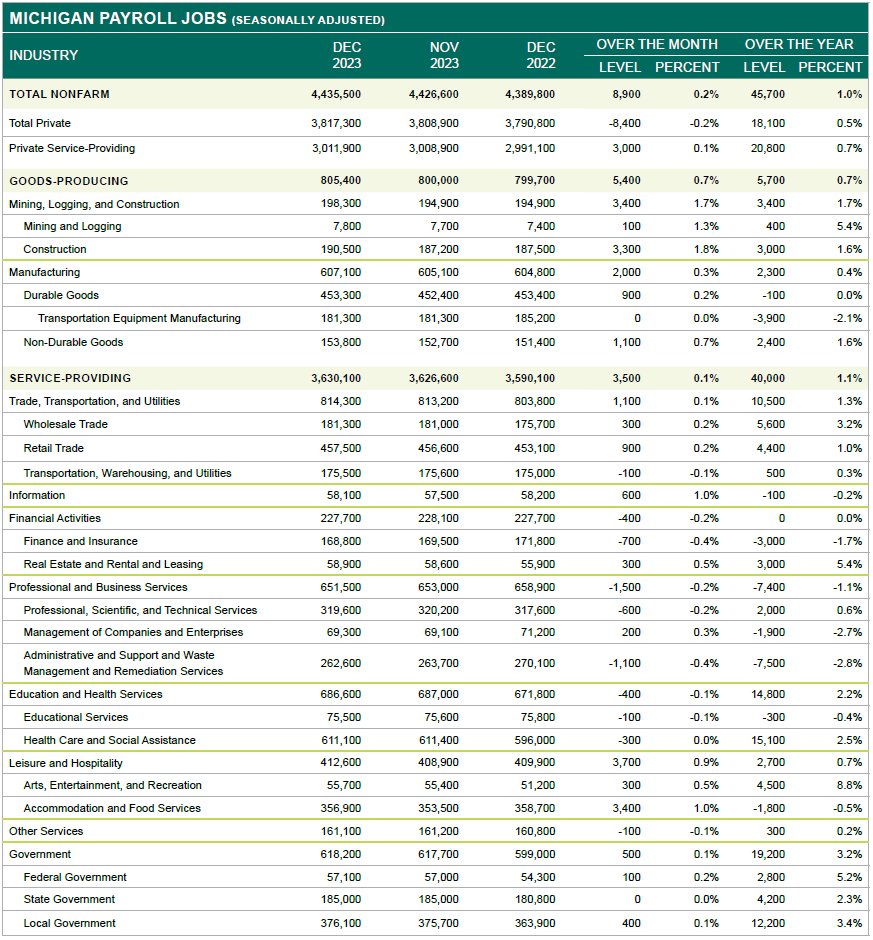
Source: Current Employment Statistics, Michigan Center for Data and Analytics, Michigan Department of Technology, Management & Budget
CHANGE IN UNION PARTICIPATION RATES BY STATE, 2022 TO 2023
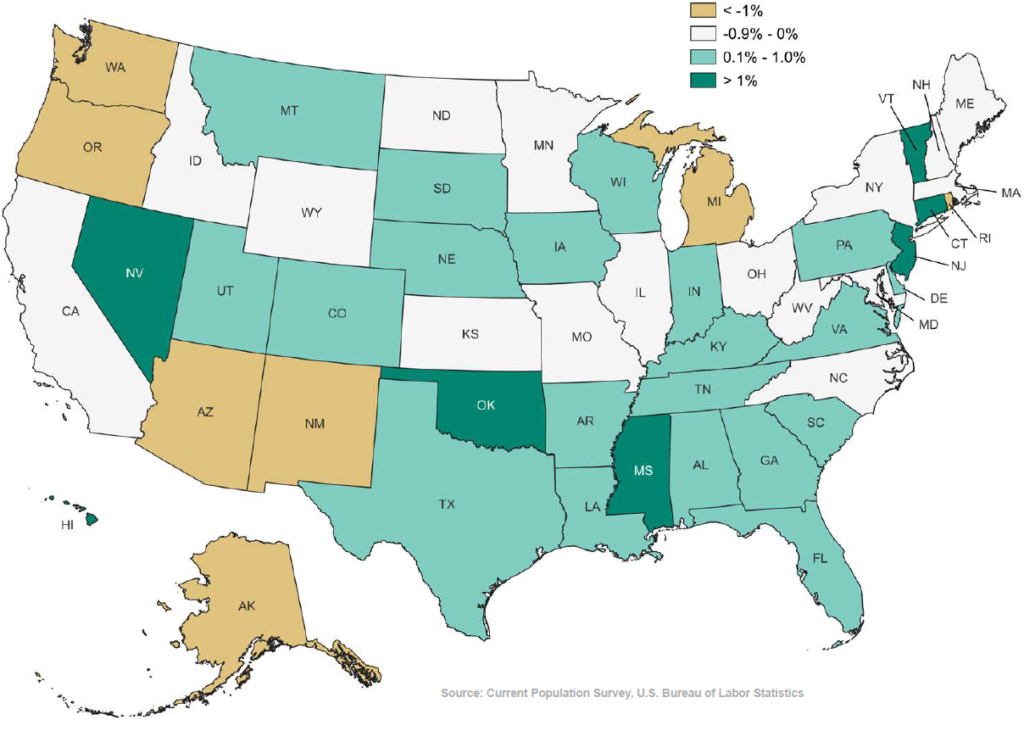
This issue’s Map of the Month features union membership rates by state from the annual union members summary from the Current Population Survey produced by the U.S. Bureau of Labor Statistics. Some key features of the data include union participation rates by geography, gender, and age. The 2023 annual summary release showed little change to union membership rates nationally, which remained steady at a 10 percent average in 2023. Hawaii and Vermont had the largest increases in union membership rates, at 2.2 percentage points, while Rhode Island had the largest decrease of 3.8 percentage points.
Michigan was one of 21 states that saw a union membership rate decline between 2022 and 2023. Among those, only seven states had a decrease greater than 1 percentage point. Michigan’s union membership declined by 1.2 percentage points, dropping from 14 percent of total employed in 2022 to 12.8 percent in 2023. Michigan’s decline was the sixth largest across the country over the year, tying with Alaska.
Both the total number of union members and the rate of union membership has generally been declining in Michigan since 2000. Although Michigan’s 12.8 percent union membership rate outpaced the nation in 2023, this rate was the state’s lowest since the turn of the century. Michigan’s 564,000 union members in 2023 was the second lowest (2021, 540,000) in that same time frame.
Despite the declines in union membership, Michigan remained a top 10 state in terms of total employed union members. With a decrease from 25,000 union members since 2022, Michigan’s 564,000 total members in 2023 still ranked ninth nationally.
CANAAN VANMALDEGHEM
Economic Analyst
JOHN DILLON
Economic Analyst
LABOR TURNOVER RISES AFTER MONTHS OF DECLINE
Michigan’s job openings rate increased in the latest iteration of the state Job Openings and Labor Turnover survey (5.4 percent). Similarly, the separations rate (3.5 percent), labor turnover rate (6.9 percent), layoffs/discharges rate (1.0 percent), and quits rate (2.4 percent) all increased in November. Both the hires rate (3.3 percent) and the unemployed persons to job openings ratio were the only two metrics to decline.
Job Openings Expand in November
Job openings increased by approximately 18,000 from October to November, jumping from 234,000 to 252,000 openings. This was reflected in an increase of 0.4 percentage points in the job openings rate (5.4 percent). Michigan’s rate was above the national rate at the time (5.3 percent) yet had the 34th highest rate compared to all other states.
The unemployed persons to job openings ratio inched downward in November, dropping from 0.88 to 0.86. This meant that for every 10 job openings, there were nearly nine individuals available to fill those positions. Michigan’s ratio was notably higher than the national ratio at the time (0.71), and was the sixth highest among all other states.
Separations Increase
The separations rate increased by 0.4 percentage points to 3.5 percent. Compared to October (138,000), approximately 19,000 more employees were separated from their positions in November (157,000). Though marginal, Michigan exceeded the national separations rate of 3.4 percent.
Both the quits rate and the layoffs/discharges rate increased in November to 2.4 percent and 1.0 percent, respectively. The change in the quits rate was the major driving force in the increase in separations, which saw a 0.4 percentage point jump that outpaced the 0.1 percentage point rise in the layoffs/discharges rate.
Hires Inched Downward
Michigan employers hired approximately 3,000 less employees in November (148,000) than the month prior (151,000). This was shown in a marginal 0.1 percentage point drop in the hires rate from 3.4 percent to 3.3 percent. Michigan was below the national hires rate at the time (3.5 percent) and was near the bottom tenth amongst all other states in this metric.
Labor Turnover Picking Up as Voluntary Separations Increase
Michigan’s labor turnover rate has trended downward in recent years. In the September JOLTS data release, the labor turnover rate reached a near three-year low at 6.5 percent, the lowest since January 2020. This low remained steady through October. However, in the latest data for November, labor turnover experienced a notable increase, moving from 6.5 percent to 6.9 percent after months of persistent decline.
The main driver of this change was separations, with an increase attributed to a rise in the quits rate. With the quits rate being a measure of voluntary separations, this indicated that the uptick in labor turnover in November was due to a rise in the number of employees choosing to separate from their employers.
Despite this, Michigan’s turnover rate remained below 7.0 percent for the fourth consecutive month, the longest stretch since 2016.
KRYSTAL JONES
Economic Analyst
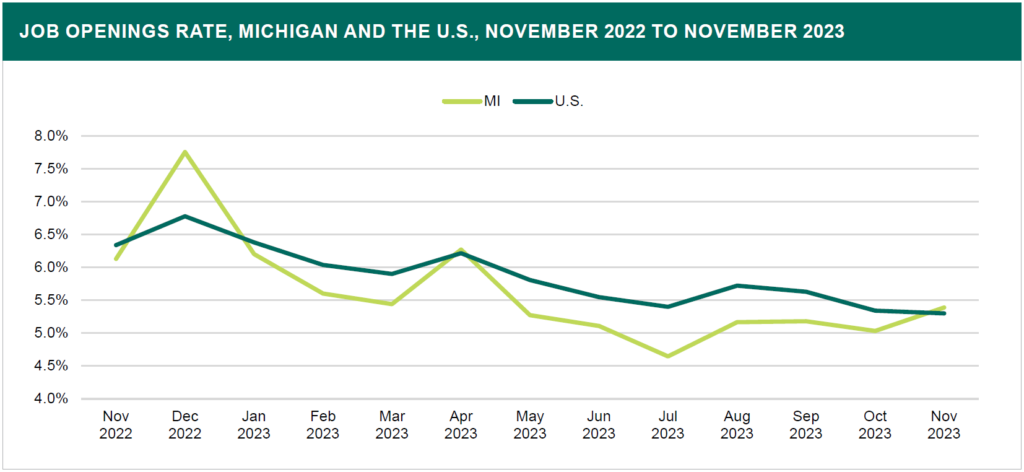
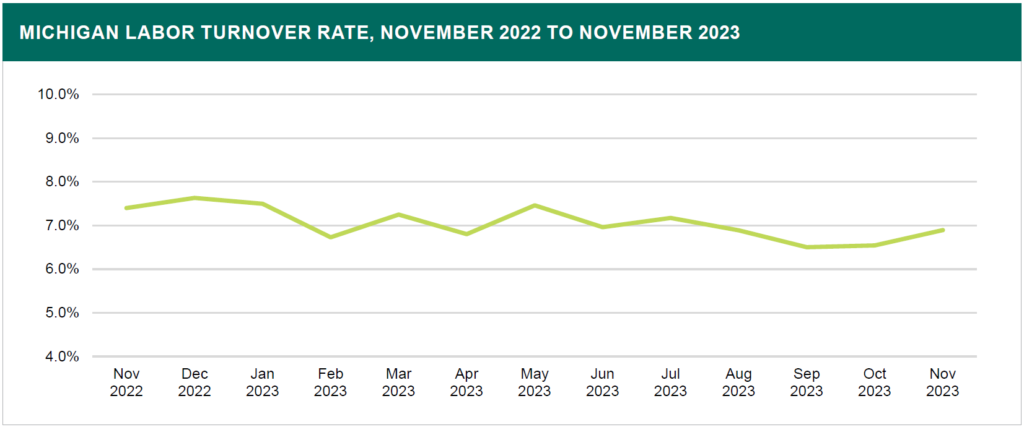
Source: Job Openings and Labor Turnover Survey, U.S. Bureau of Labor Statistics
Disclaimer
The Above Information was created and disseminated by the Department of Technology, Management, and Budget and the Bureau of Labor Market Information and Strategic Initiatives from the State of Michigan. Specialized Staffing does not hold any rights or ownership to this content. For more information, please contact your Michigan Bureau of Labor Representative.
